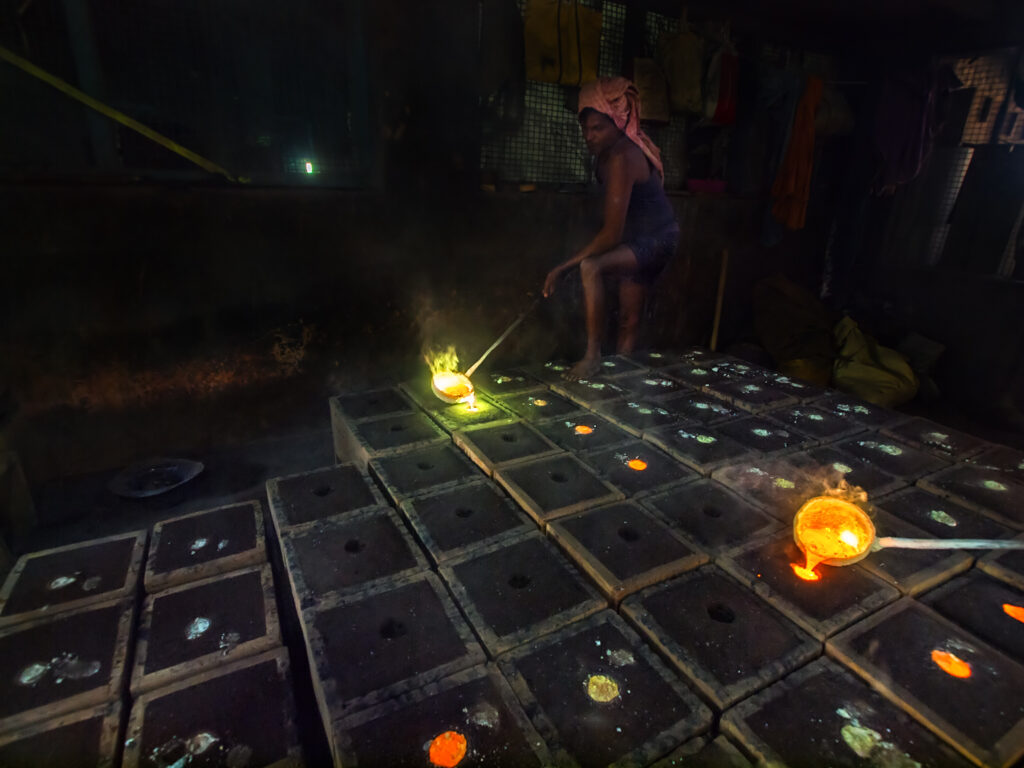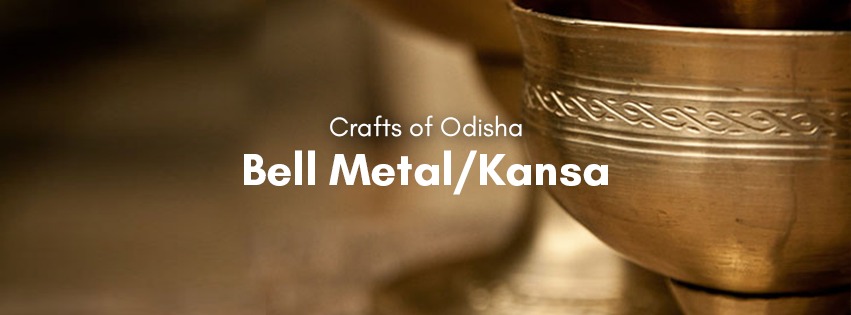Odisha, also known as “Utkal,” which literally translates to “excellence of art,” has been a treasure trove of traditional crafts since time immemorial. From the exquisite sculptures adorning the Konark temple to the intricate metalwork, generations of artisans have mastered the art of transforming the ordinary into the extraordinary.
Among these skilled craftspeople are the bell metal artisans, known by various names across different regions. In Puri, they’re called “Kansa-Karigaras” or “braziers,” while Sambalpur dubs them “Kansaris” or “Kharuras.” But no matter the name, their talent shines through in the creation of beautiful and functional brass and bell metal ware.
Imagine bustling workshops, the rhythmic clang of hammers shaping molten metal. These artisans, some referred to as “Thattaries” in Kendujhar, possess an age-old knowledge passed down through generations. In Boudh and Phulbani districts, they’re known as “Kharadas,” their villages echoing with the dedication to their craft.
Interestingly, the story of these artisans goes beyond their masterful techniques. Legend whispers of their migration from Kanyakubja, an ancient city, to Puri at the invitation of King Kapilendra Dev. His vision? To have these skilled craftsmen create utensils and ornaments worthy of Lord Jagannath, the revered deity.
Even today, the legacy continues. While some communities like the “Tamras” in Ganjam specialize in copper work, the essence remains the same – a deep respect for tradition and a passion for creating beauty that transcends time.
Odisha’s bell metal artisans are not just makers; they are storytellers, weaving their heritage into every gleaming pot and intricate design. Their work is a testament to the enduring spirit of art in this vibrant land.
Odisha’s Enduring Bell Metal Work Tradition
Metal crafts in Odisha boast a rich history, flourishing since the Ganga Dynasty in the 11th century and continuously developing to this day. The village of Balakati in Puri district stands out for its traditional production of brass, bell-metal utensils, and temple articles. This craft is said to have truly taken root around 1400 AD.
Brass and bell metal, considered “pure” metals, are the primary materials for these utensils. Stepping into Balakati, you’ll be greeted by the rhythmic sounds of hammering and the focused energy of craftspeople.
Bell Metal: A Link to the Divine
Bell metal has a special significance due to its connection to Lord Jagannath of Puri. The knowledge of crafting bell-metal objects has been passed down through generations. This alloy, dominated by copper and zinc, is considered particularly suitable for the Jagannath temple’s utensils. Locally called “kansa,” these utensils are shaped from molten metal by skilled “kansaris” before sunrise, requiring immense manual labor.
The early start has a practical reason. Heating and shaping the metal generates significant heat, making it difficult to work past mid-morning. Traditionally, kansaris resided near water bodies, as boats were once the primary mode of transport, and water was essential for cooling during the hot work. Kantilo, on the banks of the Mahanadi River, exemplifies this connection. This village, famed for its metal crafts and the Neela Madhab temple (considered the origin of Lord Jagannath), has a long history of working with brass and bell metal.
Legend has it that the Gajapati Maharaja of Puri brought the kansaris to Kantilo in 1804. Their purpose was to create beautiful, durable, and readily available brass and bell-metal utensils for Lord Jagannath’s daily use. Interestingly, bell-metal ware remains an important part of a bride’s trousseau in this community.
The Kansa Craft: A Journey from Raw Metal to Polished Utensil
Kansa is an alloy of copper and tin, creating a beautiful golden hue that deepens with age. The crafting process is a testament to human skill and patience. The Kansa craft process involves a team effort by skilled artisans, each playing a crucial role. These specialists, called “garha” (artificer), “kora” (hammer-man), “pasia” (scraper), “bhatia” (polisher), and “engrave” (engraver), transform raw metal into beautiful utensils. Here’s a glimpse into the steps involved:
The Workshop: A Community Hub
Due to space limitations, workshops are often part of the artisan’s homes. The utensils produced cater to various needs and showcase regional variations in design and clientele. Interestingly, workshops can be run by the Kansari themselves, outside financiers, or even cooperatives. The community maintains caste councils with designated areas of operation, ensuring a structured approach to the craft.
From Ingot to Bowl: The Shaping Process
- The Molten Mix: Copper and zinc are melted in a crucible at specific ratios, depending on whether brass or bell metal is desired. The molten metal is poured into molds or shaped into ingots. These ingots are then heated and hammered repeatedly on an anvil, with multiple artisans working in unison to achieve the desired shape. Balakati artisans primarily use the “Pita” method, which involves hammering pre-heated metal ingots into shape. These ingots are formed by combining copper and zinc (for brass) or copper and tin (for bell metal) in a furnace. The molten metal is then poured into small molds. Shaping the utensil is a team effort. Three to four people rhythmically hammer the heated ingot on a stone platform, while another rotates it to ensure even shaping. The metal is periodically reheated to maintain its malleability. Additional ingots can be stacked for faster production.
- A Flawless Finish: Once the desired shape is achieved, the bowl is removed and its base is coated with a coal and water mixture to withstand further shaping. After shaping, the utensils are scraped, buffed, and polished on a lathe to a gleaming finish. Some may even be adorned with intricate designs.

The Finishing Touches
The shaped bowl undergoes a series of finishing processes. It’s scraped to create a smooth surface, and the rim is filed. A master craftsman then inspects and refines the bowl on a lathe. The base is heated, and hot tar is applied to secure it to the lathe. A rotating brass wire sponge removes any remaining scrape marks, followed by a scraping knife for final touches.
Engraving with floral, ethnic, or symmetrical patterns is sometimes added for an extra decorative flair.
Traditional Tools for Timeless Beauty
The entire process relies on manual tools and raw materials. Here are some of the key instruments used:
- Hatudi (hammers)
- Sandasi (pliers)
- Ruha (file)
- Lihini (scraper)
- Kunda (lathe)
- Badia Patkar/Akarmasila (stone platform)
- Kala Pankha (hand crank blower)
- Koi (crucibles)
- Dasta (zinc)
- Tamba (copper)
- Brass Wire Sponge
- Nihai (anvil stake)
- Rala/Alakatara (tar)
For centuries, Odia artisans have mastered the art of crafting beautiful and functional objects from brass and bell metal, a unique alloy of zinc and copper. These daily use utensils are not just practical, but also boast artistic designs, making them prized possessions passed down through generations.
In fact, gifting bell-metal utensils is a cherished custom during a daughter’s wedding, signifying both utility and value. The variety is astonishing, with utensils in all sizes and designs catering to every need.
The production process itself is a fascinating display of skill. Artisans employ two methods: intricate casting in molds or shaping the metal through continuous hammering until the desired form is achieved. Their talents extend beyond utensils, with many specializing in crafting statues of deities. Places like Balakati, Kantilo, Bhuban, Baidyarajpur, Bellaguntha, and Remuna are renowned for these exquisite sculptures.
These nimble-fingered craftspeople breathe life into every object they touch, transforming metal into works of art. Their knowledge is a living legacy, passed down through generations and meticulously documented on ancient palm leaves.
Brass & Bell-Metal in Odisha: A Legacy Enduring
The Odia government actively supports these artisans, helping them refine their skills and expand their production. This has led to a surge in the quality and quantity of handcrafted items, encompassing not just brass and bell metal, but also filigree work, dhokra, textiles, horn crafts, and stone carvings.
Many artisans have joined cooperative societies, fostering collaboration and ensuring wider market access. Special emporiums in Puri, Cuttack, and Bhubaneswar showcase their creations, providing a platform for these timeless crafts to reach a wider audience. Here’s how Kansa craft has sustained in Odisha’ s various districts. (Ref: METAL BOWL MAKERS (KANSARI) IN AN EASTERN ODISHA by Dr. Umesh Chandra Nayak)
Undivided Cuttack District:
- Artisans in Baidyarajpur (Jeypur), Bindhanima (Tigiria), Bhatimunda, Ganraba, and Kanpur villages create traditional bell-metal utensils and décor.
- Co-operatives empower over 1500 artisans, providing year-round employment and ensuring local market access.
Undivided Boudh-Kandhamal:
- Gudvelipadar boasts a small-scale co-operative unit, employing 11 artisans for brass and bell-metal utensil production.
Undivided Puri District:
- This region has a rich history of working with non-ferrous metals, with expertise dating back to the 11th century Ganga dynasty rule.
- Kantilo, Khalisahi, Pratapsasan (Balakati), Bhainchua, and Muktepur are major centers for this industry, producing household items, temple accessories, ornaments, and decorative wares.
- Over 1370 skilled artisans, traditionally of the Kansari caste but also others, were involved in 1961.
- Fifteen co-operatives with 517 members assist artisans financially.
- Despite competition from aluminum, stainless steel, and ceramics, the industry thrives due to the deep connection of these metals with Odia social and cultural life.
- Kantilo’s Kansaris were once a primary source of livelihood for the vast region, encompassing both undivided Puri and the newly formed Nayagarh district.
Dhenkanal District:
- Bell-metal production is a crucial part of the district’s rural cottage industry.
- Bhuban is renowned for its exquisite brass and bell-metal utensils, attracting artisans for generations.
- Three co-operative societies formed in 1953, 1962, and 1965 support over 250 artisans financially.
- By 1967, Bhuban’s societies alone produced goods worth a lakh of rupees.
Balasore District:
- Remuna stands out as the primary center for brass and bell-metal work.
- Located near Balasore town, Remuna boasts a bustling market known for its brass utensils and vegetables.
- The annual religious fair at the Khirachora Gopinath shrine attracts large crowds and boosts sales.
Sundargarh District:
- The Kansari caste traditionally crafts brass and bell-metal utensils for daily use and women’s ornaments.
- Tangarpali is a significant center for this industry.
- Unfortunately, cheaper aluminum and plastic products, and the rise of stainless steel among the affluent, have impacted the industry’s reach.
Mayurbhanj District:
- Tribal communities showcase their skill in casting bell-metal toys and religious figures.
- Co-operative societies in Baisai and Muruda support around 62 families engaged in this art form.
- Their products have garnered a positive reputation beyond Odisha’s borders.
Beyond Utility: A Cultural Legacy
Kansa utensils are not just practical; they hold deep cultural significance. Traditionally used in rituals and daily life, they are considered symbols of purity and are even gifted during weddings. The craft itself is an integral part of Odisha’s social fabric, with generations carrying forward this ancestral knowledge.
The Future of Kansa
While facing competition from modern materials, the Kansa industry is adapting. Artisans are incorporating contemporary designs while staying true to their age-old techniques. Government initiatives and cooperative societies support the artisans, ensuring the survival of this magnificent craft.
Preserving Heritage, Embracing Tradition
In an increasingly globalized world, preserving traditional crafts like Kansa craft is crucial not only for cultural heritage conservation but also for sustainable livelihoods and economic development. By supporting artisans and promoting their exquisite craftsmanship, we can ensure that this timeless tradition continues to thrive for generations to come.
Odisha Craft Odyssey, a curatorial residency programme in collaboration between MGM Foundation and BEADS. The curatorial vision aims to foster an inclusive cultural landscape that recognizes and celebrates the artistic value of craft. This edition in 2024 focuses on the bell metal workers of Odisha, a community with a rich heritage of metalworking that is deeply embedded in the cultural fabric of Odisha. If you are a contemporary artist, designer or researcher, do apply for the Open Call.
References:
Behera, Manas Chandra. “A Study on Brass and Bell Metal Industries of Odisha.” Odisha Review (November 2017): 90–96.
Nayak, Umesh Chandra. “Metal Bowl Makers (Kansari) in an Eastern Odisha.” International Journal of Current Research 10, no. 7 (July 2018): 71326–30.









